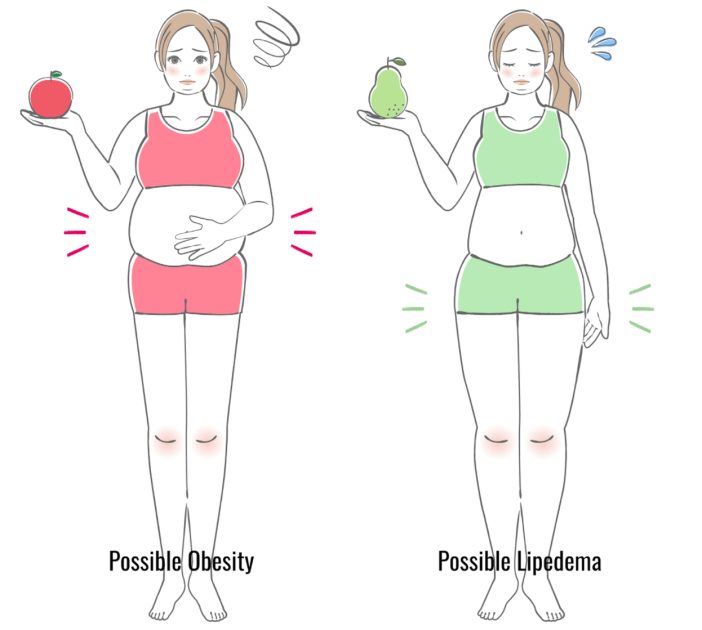Lipedema vs. Obesity Using BMI
 The biggest challenge faced by most women suffering from lipedema is the initial diagnosis. In fact, majority of patients don’t realize they have lipedema till they are well into their 40s, 50s, or even 60s. This is because there is not enough conversation surrounding lipedema.
The biggest challenge faced by most women suffering from lipedema is the initial diagnosis. In fact, majority of patients don’t realize they have lipedema till they are well into their 40s, 50s, or even 60s. This is because there is not enough conversation surrounding lipedema.
Most women are misdiagnosed with lymphedema or general obesity following high Body Mass Index (BMI). It is only after decades that some of them seek alternate explanations for their discomfort, pain, and unsuccessful weight loss efforts after exercise and diet. In some severe cases, patients also undergo bariatric surgery.
Fat cells or adipose tissue works towards providing both insulation and cushioning. Lipedema affects fat cell accumulation in the body resulting in irregular fat and bulging in the affected areas. Legs are one of the most commonly affected parts. Excessive clustering can occur in the arms as well.
Plastic Surgery Institute of Atlanta (PSI), led by plastic surgeon Dr. Paul McCluskey, provides lipedema surgery to patients in Atlanta, Marietta, Georgia, and surrounding locations.
Obesity vs. Lipedema Using BMI
Body Mass Index (BMI) is a calculation illustrating the relationship between a person’s height and weight. It equips healthcare providers with a tool to evaluate the overall health of patients. These ranges are specifically used for categorizing a person as underweight, obese, overweight, or of normal weight range.
BMI doesn’t give the full picture of a patient’s body composition breakdown or health. It is commonly used for diagnosing diseases. Body Mass Index (BMI) is an overall numerical score, such as weight or height. It is not a physical or a biological representation of overall health. The World Health Organization (WHO) defines body mass index over 30 as obese and over 25 as overweight.
This is an incomplete and inaccurate assessment. Obesity is an overall condition where fat begins affecting patients chemically, metabolically, and mechanically. However, lipedema causes fat to accumulate in an unusual proportion which causes a different type of chemical, metabolic, and mechanical impact on the body. Both lipedema and obesity result in an increased BMI. However, they are not the same. BMI for diagnosing lipedema is an unfair and incomplete assessment.
For instance, female bodybuilders may have a higher BMI. However, looking at their BMI to diagnose them as obese would result in an inaccurate diagnosis. Similarly, lipedema affects the BMI measure as well. However, a high BMI score alone is not an appropriate diagnosis of lipedema.
Metabolically, lipedema is the opposite of obesity even though both are associated with fat accumulation. However, obesity involves fat that is accumulated in the body’s central area. This is primarily present in the abdomen and is generally associated with diseases, such as high blood pressure, diabetes, cardiovascular diseases, and high cholesterol.
Lipedema, on the other hand, involves peripheral fat in the lower or upper extremities. Waist and abdomen are usually unaffected. However, both diseases cause an increase in BMI, which makes misdiagnosis both destructive and common.
The Plastic Surgery Institute of Atlanta (PSI), led by cosmetic surgeon Dr. Paul McCluskey, receives patients from Atlanta, Marietta, Georgia, and nearby areas for safe and proven lipedema surgery.
Contact Marietta, Georgia Plastic Surgeon Dr. Paul McCluskey at the Plastic Surgery Institute of Atlanta for a Consultation
For more information on procedures and treatments offered by Plastic Surgeon, Dr. Paul McCluskey and the Plastic Surgery Institute of Atlanta, visit:
Serving patients in and around Marietta, Atlanta, Roswell, Sandy Springs, Alpharetta, Buckhead, Morningside/Lenox Park, Virginia-Highland, Candler Park, Midtown, Inman Park, Poncey-Highland, Ormewood Park, Georgia and other surrounding areas.




Book Now: (404) 255-3555